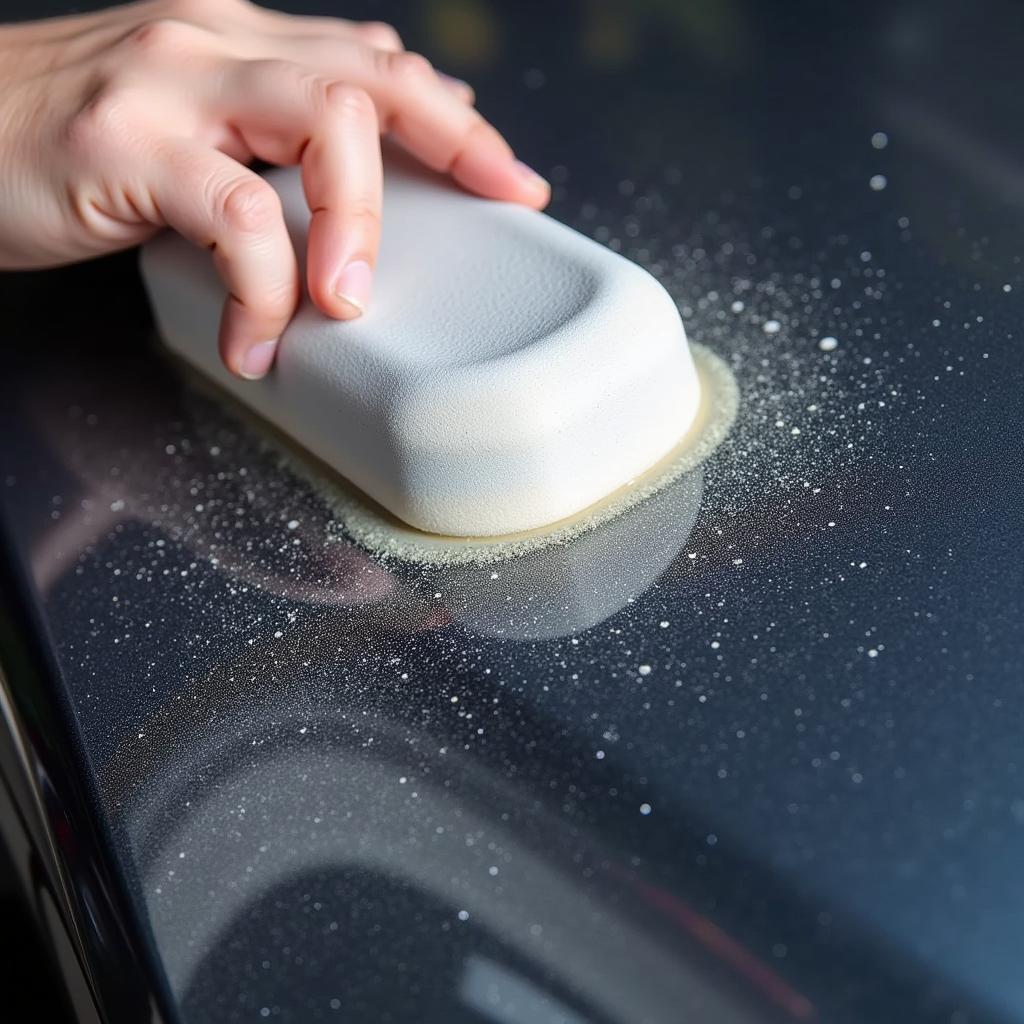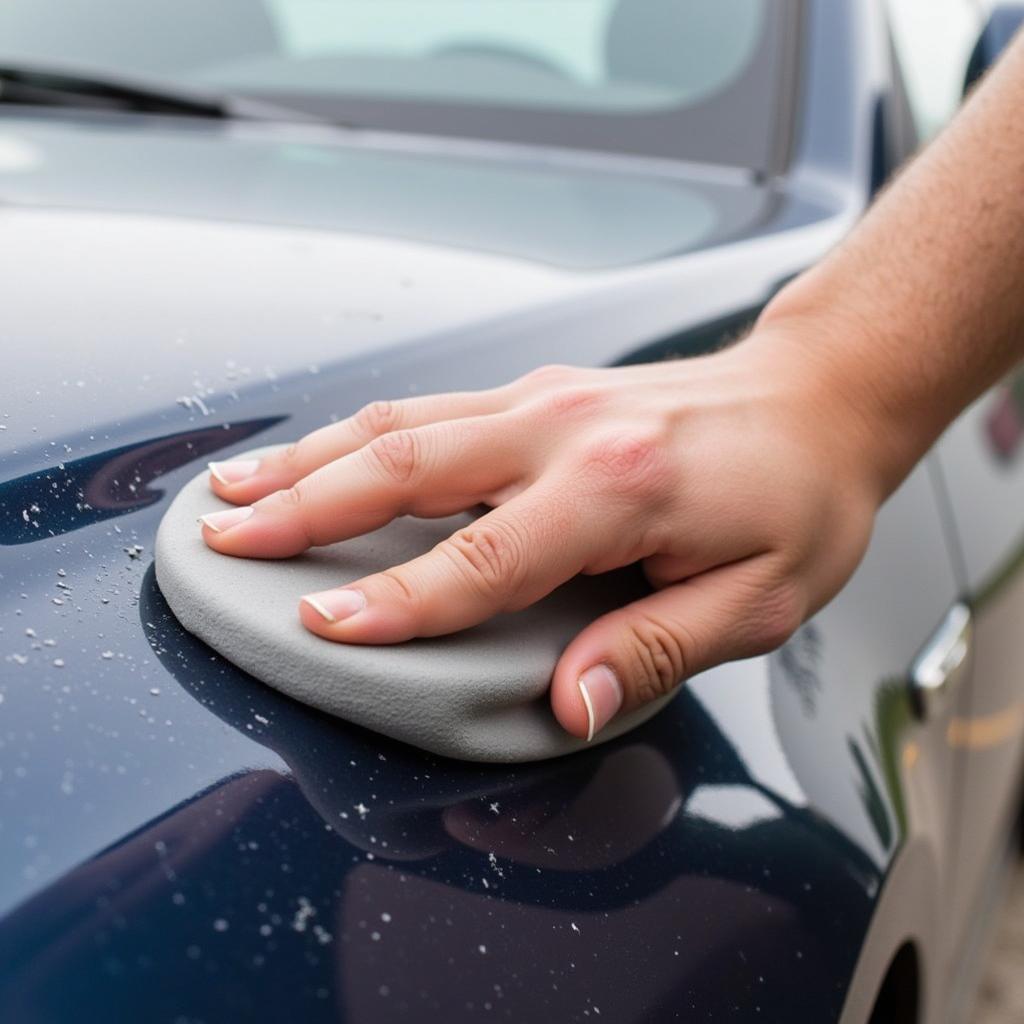Clay car detailing is a crucial step in achieving a truly flawless finish on your vehicle’s paintwork. It goes beyond a simple wash and wax, removing contaminants that traditional methods leave behind. This process involves using a specially formulated clay bar to gently lift embedded particles, leaving a smooth, glass-like surface ready for polishing and protection. Learn how this essential detailing technique can elevate your car’s appearance and preserve its value.
Why is Clay Car Detailing Important?
Even after washing and waxing, your car’s paint can still feel rough to the touch. This is because microscopic contaminants like industrial fallout, brake dust, tree sap, and even paint overspray can become embedded in the clear coat. These particles not only dull the paint’s shine but can also cause micro-scratches during washing. Clay car detailing effectively removes these stubborn contaminants, creating a perfectly smooth surface for subsequent detailing steps. Using a clay bar is like giving your car’s paint a deep cleanse, restoring its original luster and preparing it for optimal protection. Have you ever wondered how professional detailers achieve that showroom shine? Clay detailing is often their secret weapon. What is clay used for in car detailing explains the benefits in more detail.
Imagine running your hand across a seemingly clean surface only to find it still feels slightly gritty. That’s where clay car detailing comes in. It’s the process of using a specialized clay bar to remove these ingrained contaminants.
 Clay bar removing contaminants from car paint
Clay bar removing contaminants from car paint
How Does Clay Bar Detailing Work?
The clay bar itself is a pliable material designed to gently lift these embedded particles without scratching the paint. When lubricated with a dedicated detailing spray, the clay glides across the surface, trapping contaminants within its structure. It’s important to note that clay detailing is not abrasive, making it safe for clear coats when used correctly. How to use clay bar car detail provides a comprehensive guide on the proper technique.
The Benefits of Clay Car Detailing
Clay bar car detailing offers a multitude of benefits beyond simply removing contaminants. A smooth surface enhances the gloss and depth of the paint, making it appear richer and more vibrant. This is because contaminants scatter light, reducing the paint’s reflectivity. By removing these particles, you allow the paint to reflect light more evenly, resulting in a noticeably improved shine. What is clay bar for car detailing outlines all the advantages this process brings to your car’s finish.
- Enhanced gloss and shine
- Smoother paint surface
- Improved wax and sealant bonding
- Removal of embedded contaminants
When Should You Use a Clay Bar?
Clay bar detailing is recommended before applying wax or sealant. A clean, smooth surface allows these protectants to bond more effectively, maximizing their durability and performance. Think of it like preparing a wall for painting – a smooth surface ensures better adhesion and a more even finish. While not necessary for every wash, claying your car 1-2 times a year, or before a major detailing session, can significantly improve its overall appearance. How to use clay for car detailing explains the frequency and timing of clay bar application in more detail.
“Clay detailing is a game-changer. The difference in smoothness and shine is remarkable. It’s an essential step for anyone serious about car care.” – David Miller, Automotive Detailing Expert
Choosing the Right Clay Bar
Various types of clay bars are available, ranging from fine to medium grade. Fine grade clay is ideal for lightly contaminated vehicles, while medium grade is better suited for more heavily embedded particles. It’s always best to start with the finest grade and move to a more aggressive clay only if necessary. Choosing the right clay bar depends on the condition of your car’s paint.
“Start with a fine-grade clay bar and assess the results. If necessary, progress to a medium-grade clay for more stubborn contaminants. Always err on the side of caution to avoid unnecessary abrasion.” – Sarah Johnson, Automotive Paint Specialist
Is Clay Bar Detailing Difficult?
Clay bar detailing might seem intimidating, but it’s a relatively straightforward process with the right guidance. What is clay bar car detailing provides step-by-step instructions and valuable tips to make the process easy and enjoyable, even for beginners.
 Applying a clay bar with lubricant on a car’s surface
Applying a clay bar with lubricant on a car’s surface
In conclusion, clay car detailing is a valuable technique that elevates the appearance and protects the value of your vehicle. By removing embedded contaminants, it enhances the paint’s gloss, smoothness, and overall finish. Understanding what clay car detailing is and how it benefits your car can help you achieve a truly professional-level detailing result.
FAQ
- How often should I clay bar my car? 1-2 times a year, or before major detailing.
- What type of clay bar should I use? Start with fine-grade clay.
- Is clay bar detailing safe for my car’s paint? Yes, when used correctly with proper lubrication.
- Can I reuse a clay bar? Yes, if it’s not contaminated with debris.
- What is the best lubricant to use with a clay bar? Dedicated clay bar lubricants are recommended.
- Do I need to wash my car before clay bar detailing? Yes, thorough washing is essential.
- What should I do after clay bar detailing? Apply wax or sealant for protection.
For further information and detailed guides, explore our articles on clay bar detailing techniques and benefits. You might also find our articles on paint correction and car waxing helpful.
Need personalized assistance? Contact us via WhatsApp: +1(641)206-8880, Email: [email protected]. Our 24/7 customer support team is ready to help.

Leave a Reply